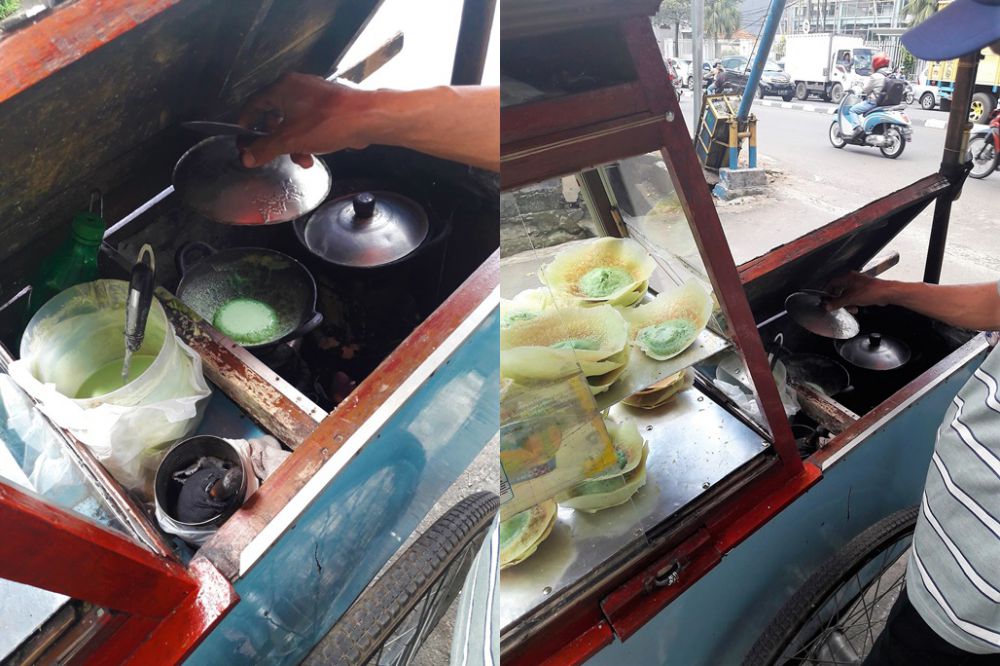(Photo: Brilio.net/Retno Wulandari)
Anyone who has spent time in Jakarta know that part of the city's strength can be found in the street vendors that line its streets. From savory lunch food to sweet treats for an afternoon snack or for when you're stuck in traffic there are all kinds of food to choose from. One of the most popular treats would be a pancake-shaped cake that is thick and soft at the center but thin and crisp on the edges. Locals call it "kue ape", a typical Betawi streetfood which name allegedly comes from the question:"kue ape nih, bang?"("what cake is this, sir?"asked in Betawi accent).
Whether or not this is true, kue ape has long been a favorite for locals, and one sunny afternoon, I chanced upon a vendor around the Petamburan area in Central Jakarta. My nose caught an inviting, mouth-watering warmth coming from a cookie dough from a cart under a colorful umbrella.

Kue Ape Peddler in Petamburan Jakarta
2017 brilio.net/Retno Wulandari
Without a second thought, I approached the vendor, whose name I later learned was Pak Enden, and ordered myself a portion, with chocolate and cheese toppings. As he made my order, I asked him a few questions about his cakes.
How long have you been selling kue ape?
Ive been doing this for quite a long time.Seven years ago, actually, [since] I first came to Jakarta. I came from Sukabumi, where I used to be a trader in a traditional market, selling clothes, accessories, stuff like that. But then a friend asked me to come with him to this city "to make more money."
How did you start? And why kue ape?
I have a friend who sells kue ape, and, sometimes, when I would visitJakarta, I would meet with him and he would teach me how to make this cake. I wanted to follow in his footsteps, selling kue ape, and then I managed to collect some money. With that money I bought this cart and equipment, I also honed my ability to make the dough and to bake the cake like this.
So you make this dough on your own? Could you tell me the ingredients?
Yes, I make them every two nights at home. The main ingredient is rice flour, wheat flour, and white sugar. To get the green color, I use suji and pandan leaves to make it fragrant, and green food coloring. The recipe is quite simple, but you need to use these small clay woks to make kue ape. Otherwise, you wont be able to attain such a form.

The making of kue ape
How many cakes do you usually sell everyday?
The amount is uncertain, but Ive got enough to support myself and my family. They arent always sold out, but I can preserve the dough in the fridge. I bake the cake in the wok in small amountsso that when peoplecome to buy, they'd will be still warm. If those cakes get cold, they wont taste as delicious as the freshly-baked ones.
Do your family help you make these cakes?
No, I live alone in Jakarta in a rented house. My wife and three kids are in my hometown in Sukabumi [West Java]. We cant afford the living cost here, so its better if they remain in our village. Whats important is that I can make a living for us here so that my children can adequate education. I used to come home once a month.
As a kue ape vendor, do you have any unforgettable experience?
Sure. I remember a few months ago when I was contracted to fill the food stalls in a hotel in many events, such as birthdays. The hotel contracted me for one whole week, along vendors sellingkue pancong and es doger, with all of our carts and equipment. The guests, especially children, were excited to watch us making our cakes. Since then, besides making my rounds selling kue ape, I also accept cake orders.
(brl/red)